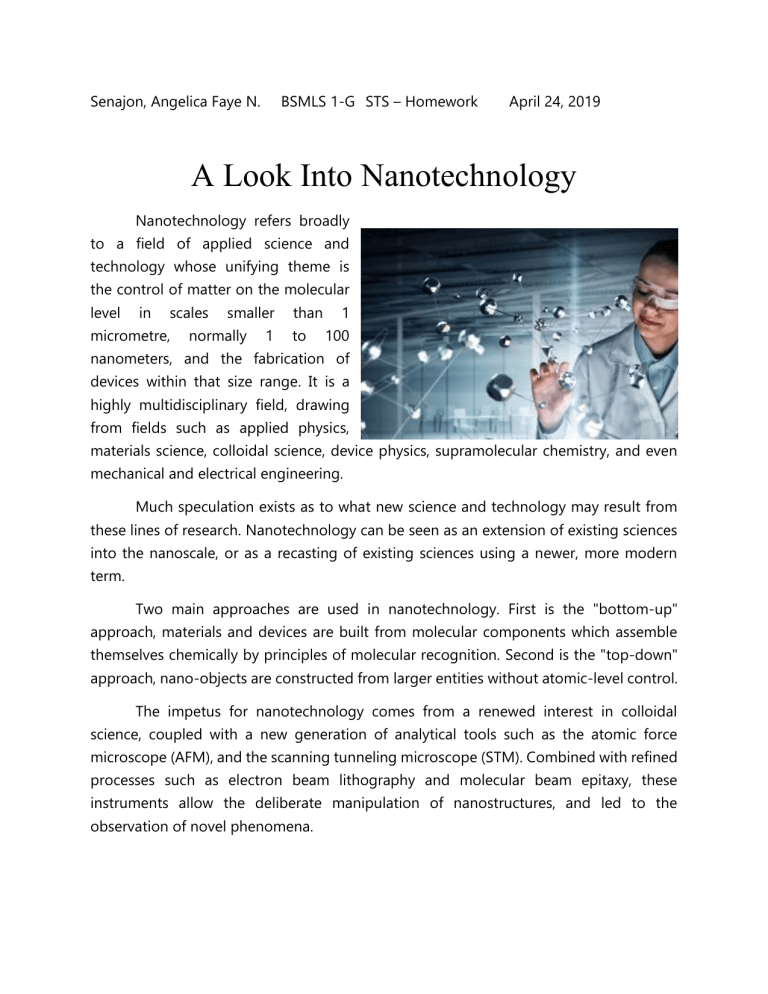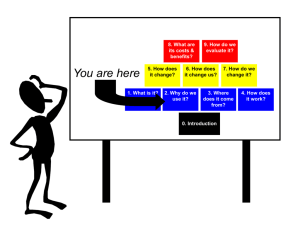
Senajon, Angelica Faye N. BSMLS 1-G STS – Homework April 24, 2019 A Look Into Nanotechnology Nanotechnology refers broadly to a field of applied science and technology whose unifying theme is the control of matter on the molecular level in scales micrometre, smaller normally 1 than to 1 100 nanometers, and the fabrication of devices within that size range. It is a highly multidisciplinary field, drawing from fields such as applied physics, materials science, colloidal science, device physics, supramolecular chemistry, and even mechanical and electrical engineering. Much speculation exists as to what new science and technology may result from these lines of research. Nanotechnology can be seen as an extension of existing sciences into the nanoscale, or as a recasting of existing sciences using a newer, more modern term. Two main approaches are used in nanotechnology. First is the "bottom-up" approach, materials and devices are built from molecular components which assemble themselves chemically by principles of molecular recognition. Second is the "top-down" approach, nano-objects are constructed from larger entities without atomic-level control. The impetus for nanotechnology comes from a renewed interest in colloidal science, coupled with a new generation of analytical tools such as the atomic force microscope (AFM), and the scanning tunneling microscope (STM). Combined with refined processes such as electron beam lithography and molecular beam epitaxy, these instruments allow the deliberate manipulation of nanostructures, and led to the observation of novel phenomena. Examples of nanotechnology in modern use are the manufacture of polymers based on molecular structure, and the design of computer chip layouts based on surface science. Despite the great promise of numerous nanotechnologies such as quantum dots and nanotubes, real commercial applications have mainly used the advantages of colloidal nanoparticles in bulk form, such as suntan lotion, cosmetics, protective coatings, and stain resistant clothing. Modern synthetic chemistry has reached the point where it is possible to prepare small molecules to almost any structure. These methods are used today to produce a wide variety of useful chemicals such as pharmaceuticals or commercial polymers. This ability raises the question of extending this kind of control to the next-larger level, seeking methods to assemble these single supramolecular molecules into assemblies consisting of many molecules arranged in a well-defined manner. These approaches utilize the concepts of molecular self-assembly and/or supramolecular chemistry to automatically arrange themselves into some useful conformation through a bottom-up approach. The concept of molecular recognition is especially important: molecules can be designed so that a specific conformation or arrangement is favored due to non-covalent intermolecular forces. The Watson-Crick base-pairing rules are a direct result of this, as is the specificity of an enzyme being targeted to a single substrate, or the specific folding of the protein itself. Thus, two or more components can be designed to be complementary and mutually attractive so that they make a more complex and useful whole. There's an unprecedented multidisciplinary convergence of scientists dedicated to the study of a world so small, we can't see it -- even with a light microscope. That world is the field of nanotechnology, the realm of atoms and nanostructures. Nanotechnology is so new, no one is really sure what will come of it. Even so, predictions range from the ability to reproduce things like diamonds and food to the world being devoured by self-replicating nanorobots. In a lecture called "Small Wonders:The World of Nanoscience," Nobel Prize winner Dr. Horst Störmer said that the nanoscale is more interesting than the atomic scale because the nanoscale is the first point where we can assemble something -- it's not until we start putting atoms together that we can make anything useful. One of the exciting and challenging aspects of the nanoscale is the role that quantum mechanics plays in it. The rules of quantum mechanics are very different from classical physics, -which means that the behavior of substances at the nanoscale can sometimes contradict common sense by behaving erratically. You can't walk up to a wall and immediately teleport to the other side of it, but at the nanoscale an electron can - it's called electron tunneling. Substances that are insulators, meaning they can't carry an electric charge, in bulk form might become semiconductors when reduced to the nanoscale. Melting points can change due to an increase in surface area. Much of nanoscience requires that you forget what you know and start learning all over again. So, what does this all mean? Right now, it means that scientists are experimenting with substances at the nanoscale to learn about their properties and how we might be able to take advantage of them in various applications. Engineers are trying to use nanosize wires to create smaller, more powerful microprocessors. Doctors are searching for ways to use nanoparticles in medical applications. Still, we've got a long way to go before nanotechnology dominates the technology and medical markets. Nanotechnology can almost be applied in our everyday lives. One application of nanotechnology in medicine currently being developed involves employing nanoparticles to deliver drugs, heat, light or other substances to specific types of cells, such as cancer cells. Particles are engineered so that they are attracted to diseased cells, which allow direct treatment of those cells. This technique reduces damage to healthy cells in the body and allows for earlier detection of disease. For example, nanoparticles that deliver chemotherapy drugs directly to cancer cells are under development. Nanoelectronics holds some answers on expanding the capabilities of electronics devices can be expanded while reducing their weight and power consumption. These include improving display screens on electronics devices and increasing the density of memory chips. Nanotechnology can also reduce the size of transistors used in integrated circuits. One researcher believes it may be possible to put the power of all of today’s present computers in the palm of your hand. References: Bradley, P. (2013). Everyday applications of nanotechnology. Community College Week. Retrieved from http://ccweek.com/article-2630-everyday-applications-of- nanotechnology.html on April 23, 2019 Bonsor, K. & Strickland, J. (n.d.). How nanotechnology works. How Stuff Works. Retrieved from https://science.howstuffworks.com/nanotechnology4.htm on April 23, 2019 Physics Org. (n.d.). Nanotechnology news. Retrieved from https://phys.org/nanotechnews/ on April 23, 2019 Science Daily, (n.d.). Nanotechnology. Retrieved https://www.sciencedaily.com/terms/nanotechnology.htm on April 23, 2019 from



